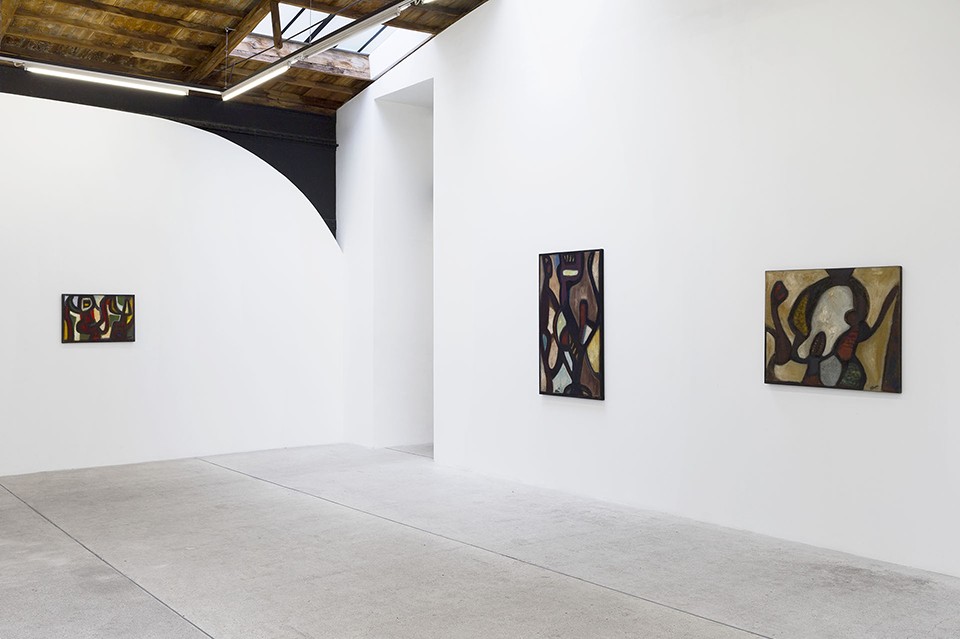Jean-Michel Atlan
27 Jan - 24 Feb 2018
JEAN-MICHEL ATLAN
27 January - 24 February 2018
Let’s come back to Atlan’s statement: “Like a dancer, I have to feel that the whole of my surface is at my disposal.” For Atlan, easel painting means neither constraint (in spatial terms) nor convention (in rhetorical terms). Paradoxically, those limits common to the painters of the said school of Paris and which give such a conventional air to so many works of the time, simply do not apply to Atlan’s work. Oils on canvas, pastels, drawings, prints, illustrations, all answer to the same logic, the same underlying necessity, and what dances and will always dance in the painting, while confined to the easel, will never become its hostage. The dancing movement within the painting is livelier than the limits the legacy supposes and might impose: the movement transcends the artefact. Atlan at times seems closer to Kline, De Kooning and Pollock or other American painters than to his Parisian contemporaries. The difference between the school of Paris and the American painters isn’t only a question of format, as some over-hasty systematisers have put it. Atlan paints most of the time within a format, within a framework, which, from a strictly formalist point of view, would make us associate him with the school of Paris – whereas the mystical substratum of his painting, as well as the liberty of his gesture, bring him closer to the Americans, whom he in many ways precedes. Witness, for example, the early works of Clyfford Still. Anyone still able to equate Atlan’s work with that of certain members of the school of Paris is thinking only in terms of a system of representation (easel-paintings), with no regard for genetic space. What characterises Atlan’s work is that he never loses sight of that genetic space, well aware that it is antecedent to any choice of medium and is never determined by the medium selected.
Alain Bonfand - Translated from the French by Kenneth White
Excerpt from Catalogue Raisonné of the Complete Works
27 January - 24 February 2018
Let’s come back to Atlan’s statement: “Like a dancer, I have to feel that the whole of my surface is at my disposal.” For Atlan, easel painting means neither constraint (in spatial terms) nor convention (in rhetorical terms). Paradoxically, those limits common to the painters of the said school of Paris and which give such a conventional air to so many works of the time, simply do not apply to Atlan’s work. Oils on canvas, pastels, drawings, prints, illustrations, all answer to the same logic, the same underlying necessity, and what dances and will always dance in the painting, while confined to the easel, will never become its hostage. The dancing movement within the painting is livelier than the limits the legacy supposes and might impose: the movement transcends the artefact. Atlan at times seems closer to Kline, De Kooning and Pollock or other American painters than to his Parisian contemporaries. The difference between the school of Paris and the American painters isn’t only a question of format, as some over-hasty systematisers have put it. Atlan paints most of the time within a format, within a framework, which, from a strictly formalist point of view, would make us associate him with the school of Paris – whereas the mystical substratum of his painting, as well as the liberty of his gesture, bring him closer to the Americans, whom he in many ways precedes. Witness, for example, the early works of Clyfford Still. Anyone still able to equate Atlan’s work with that of certain members of the school of Paris is thinking only in terms of a system of representation (easel-paintings), with no regard for genetic space. What characterises Atlan’s work is that he never loses sight of that genetic space, well aware that it is antecedent to any choice of medium and is never determined by the medium selected.
Alain Bonfand - Translated from the French by Kenneth White
Excerpt from Catalogue Raisonné of the Complete Works

